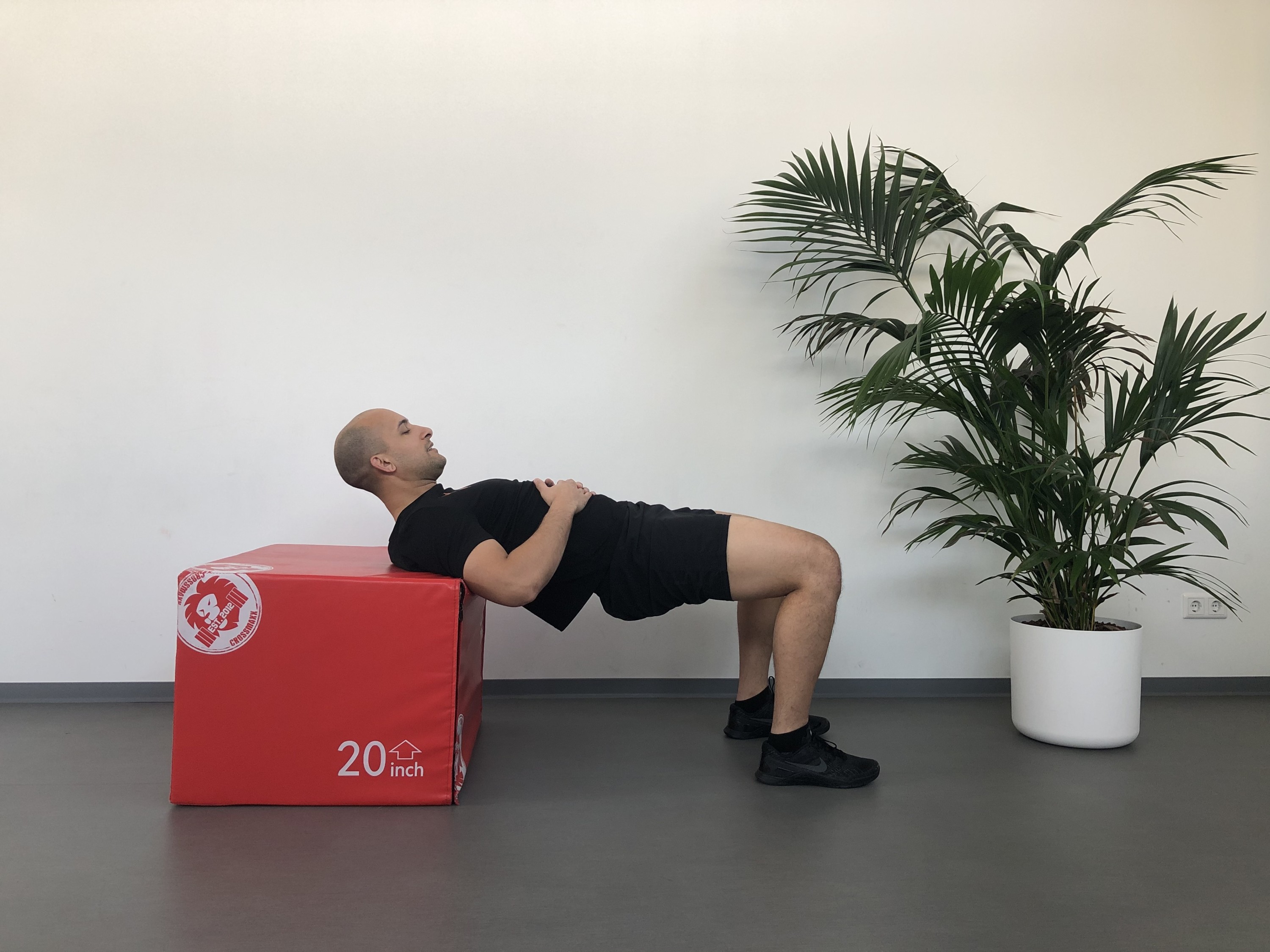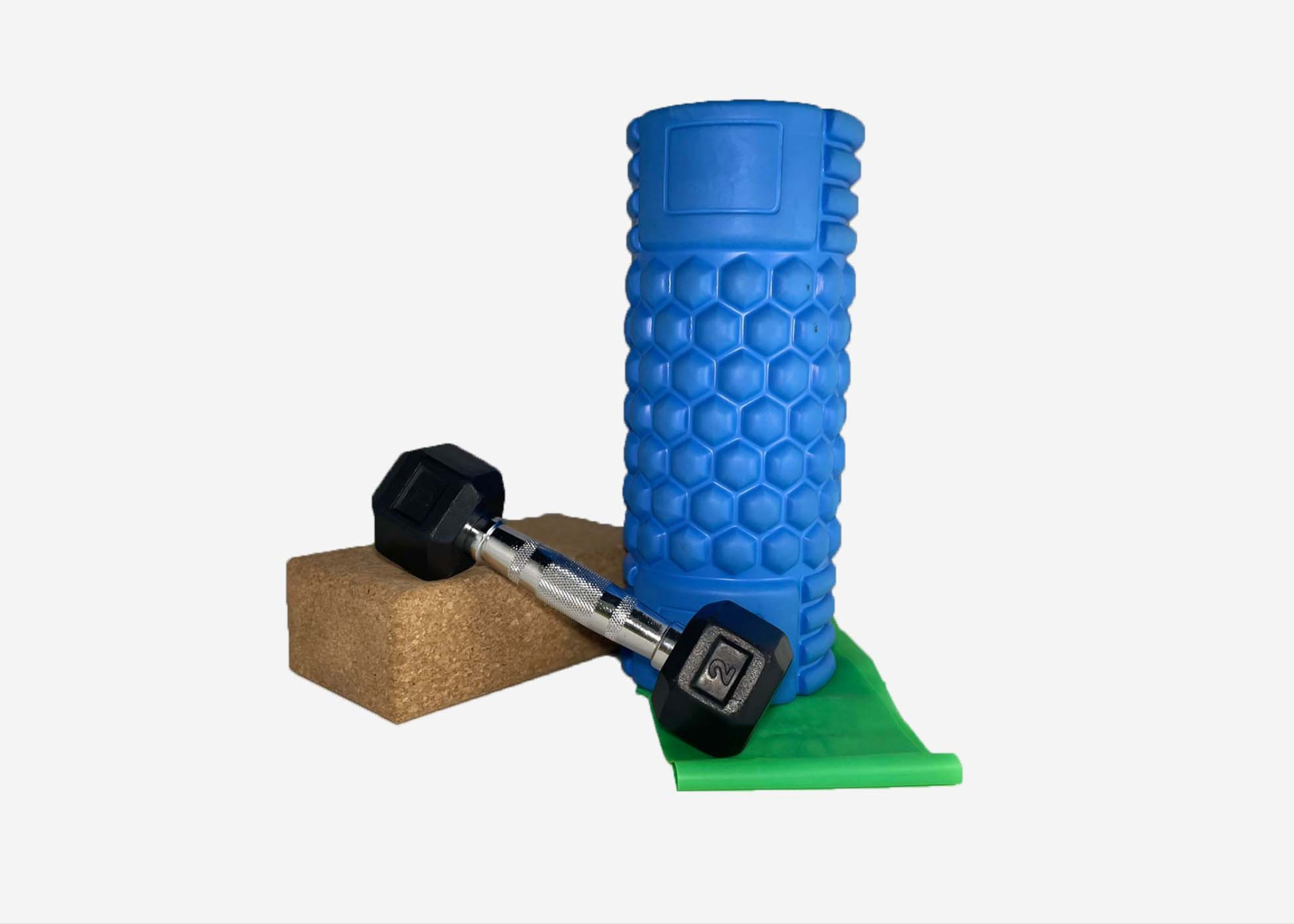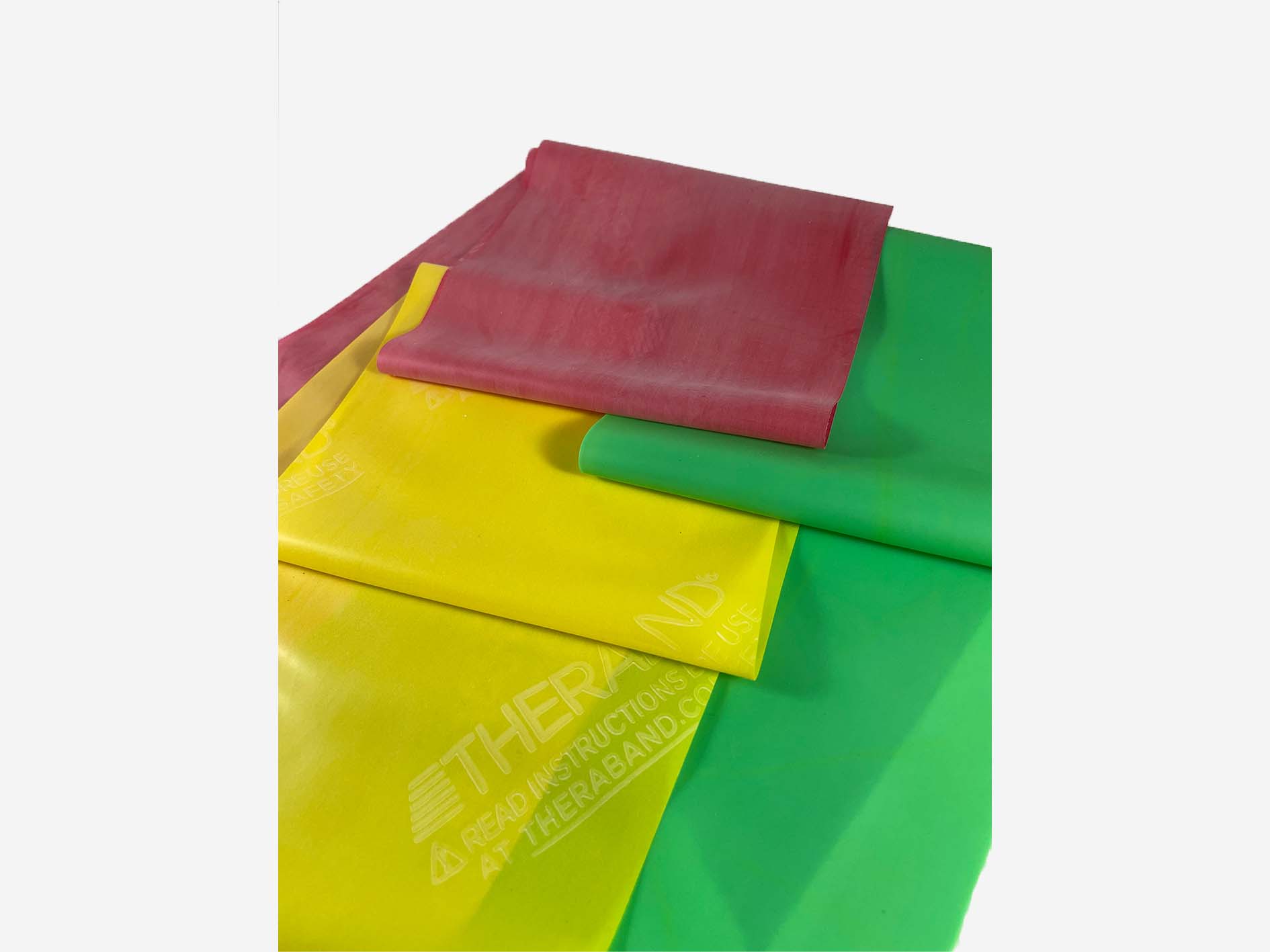
Lumbar disc herniation
The disc (intervertebral disc) that lies between the vertebrae consists of a gel core surrounded by the circular layers of collagen. If pressure on the disc increases it can be injured, resulting in a bulging disc (protrusion) or rupture of the outer layers allowing the jelly substance to leak out of the disc (prolapse). This can cause a local inflammation that can irritate the nerves. A prolapsed disc is also known as a herniated disc. The following exercsies can be supportive to recover from a herniated disc.
1. Extensie McKenzie
Ga op de buik liggen, plaats de armen naast de borst op de grond, druk jezelf vervolgens vanuit de armen omhoog en kom vervolgens weer langzaam terug omlaag.
2. Extensie
Extensie, plaats het elastiek om de enkel van het aangedane been. Breng vanuit gestrekte positie het been naar achteren met gestrekte knie, let erop dat je rechtop blijft met je bovenlijf. Ga vervolgens weer terug naar de beginhouding.
3. Rear kick
Rear kick, ga op je buik liggen. Breng vervolgens één voor één je benen gestrekt omhoog en weer terug.
4. Isometrische deadbug
Isometrische daadbug, plaats een elastiek rondom je voorvoeten en kom op je rug liggen met heup en knieën beide 90gr gebogen. Strek één been uit en hou het elastiek op spanning. Kom terug naar de startpositie en herhaal aan de andere kant.
5. Deadbug met bal
Deadbug met bal, kom op je rug liggen en klem een grote bal tussen je knieën en ellebogen. Strek vervolgens diagonaal één been en één arm uit en weer terug. Herhaal de beweging aan de andere kant.
6. Deadbug pullover beginner
Deadbug pullover beginner, kom op je rug liggen, met je knieën gebogen en de voeten van de grond. Hou boven je hoofd een elastiek op spanning die met de andere kant aan een paal vast zit. Beweeg nu één voor één je voeten tot net boven de grond en weer terug. De knieën blijven gebogen.
7. Deadbug palov press
Deadbug palov press, kom op je rug liggen met de benen van de grond, waarbij je knieen gebogen zijn. Strek vervolgens één been uit tot net boven de grond. Hou met je handen een elastiek vast, wat aan één kant vastgemaakt zit rondom een paal. Strek vervolgens je handen boven je borst uit en weer terug.
8. High plank
Start in voorligsteun en plaats de handen op schouderbreedte. Span de buikspieren goed aan om een holle rug te voorkomen. Houd deze houding zo lang mogelijk vast.
9. Low plank op de knieën
Ga op de knieën zitten, plaats de ellebogen voor je op de grond, zorg dat het hele lijf behalve de armen en knieën van de grond zijn, probeer in één rechte lijn te blijven met je hele lijf.
10. Low plank
Ga op de buik liggen. Houdt de benen gestrekt, zorg dat de ellebogen recht onder de schouders staan, kom vervolgens met je gehele lijf van de grond af dusdanig dat je in één lijn blijft.
11. Side plank knieën
Ga op de knieën zitten en plaats de ellebogen naast je op schouderhoogte. Zorg dat het bovenlichaam in een lijn is met het onderlichaam. Span de buikspieren goed aan.
12. Side plank
Ga op de zij liggen, zorg dat de elleboog recht onder de schouder staat. Kom vervolgens de de romp en de heupen van de grond en zorg dat je in één lijn blijft. Houdt deze beweging vast.
13. Side plank star
Side plank star, neem steun op de voeten, zorg dat de elleboog recht onder de schouder staat. Kom vervolgens met de romp en de heupen van de grond en zorg dat je in één lijn blijft. Hef nu je bovenste been omhoog.
14. Palov press in stand
Zet uw benen op schouderbreedte. Pak het elastiek en stoot met beide armen naar voren uit. U zult voelen dat u uw buikspieren moet aanspannen door de weerstand van het elastiek. Let erop dat uw bekken gekanteld zijn (navel intrekken).
15. Palov Press in stand lunge (Core)
Ga in een uitvalspas staan (of lunge). Pak het elastiek vast (ongeveer borsthoogte) en stoot deze voor u uit. Haal rustig terug naar uw borst en stoot vervolgens weer uit.
16. Palov press rotatie in stand lunge (Core)
Ga in een uitvalspas staan (of lunge). Pak het elastiek vast en maak een rotatie naar links of naar rechts. Probeer zo goed mogelijk weerstand te houden op het elastiek. Hiermee wordt bedoelt dat u niet helemaal terug draait met het elastiek zoals op de video.
17. Squat (hoog, midhoog, laag)
Zet de voeten op heup breedte, maak de beweging alsof je op een stoel gaat zitten. De billen naar achteren en de knieën blijven achter de tenen. Kom omhoog en herhaal de beweging.
18. Lunge op verhoging
Lunge op verhoging, zet de handen in de zij, plaats één been vooruit op de step, ga vervolgens met het achterste been naar de grond. Kom weer omhoog en herhaal deze beweging.
The meaning of a lumbar disc herniation
The disc (intervertebral disc) that lies between the vertebrae consists of a gel core surrounded by the circular layers of collagen. If pressure on the disc increases it can be injured, resulting in a bulging disc (protrusion) or rupture of the outer layers allowing the jelly substance to leak out of the disc (prolapse). This can cause a local inflammation that can irritate the nerves. A prolapsed disc is also known as a herniated disc.
The causes of a lumbar disc herniation
There are many causes for injury to the discs, but repetitive movements are a common source of injury. Your genetic makeup may play a role. Other known risk factors are: lack of movement, smoking, stress, a sedentary lifestyle and heavy loading. Men, especially taller men, are at increased risk of injuring an intervertebral disc.
The symptoms of a lumbar disc herniation
The pressure on the nerves due to the inflammation can cause pain, pins and needles, numbness and a burning feeling in the gluteal region and down the back of the leg. It can radiate all the way down to the foot. Couching, sneezing or increasing intra abdominal pressure can aggravate the symptoms. Certain postures or movements, like bending, can aggravate or relieve the symptoms. Reduced strength in leg muscles can occur in more severe cases.
The treatment of a lumbar disc herniation
The prognosis for recovery is good and most people will recover naturally within 12 weeks. The physiotherapist can aid recovery with exercise therapy. They can educate you on positions and postures that help minimize irritation of the nerves. Pain medication can be used to alleviate the pain. Paracetamol is recommended for minor pain. Non steroid anti-inflammatory drugs (NSAIDs) like Ibuprofen or Voltaren are stronger medications. These can have side effects or interfere with other medications (heart medication) and it is important to read the instructions or contact your doctor or chemist prior to use.
Recent update
80% of prolapsed lumbar discs heal without any interference and surgery is not necessary. CT, MRI or X-ray imaging can not always determine where the pain is coming from. Movement is recommended when suffering from back pain and some pain with movement does not mean there is tissue damage!
Synonyms
Acute low back pain, lumbage, sciatica, numbness in the leg, radiating pain in the leg, pins and needles in the leg, lumbar pain, severe back pain, slipped disc, herniated disc, prolapsed disc, disc desiccation, intervertebral disc, lumbar discs
Advice
If you have any questions regarding the exercises, doubt if you are doing them correctly or aren’t sure they are suited for your condition, please contact your physiotherapist for support.
Attention:
Yourbody.coach offers a range of exercises. Yourbody.coach can not be held responsible if you develop injuries. Always consult your physiotherapist or specialist.

